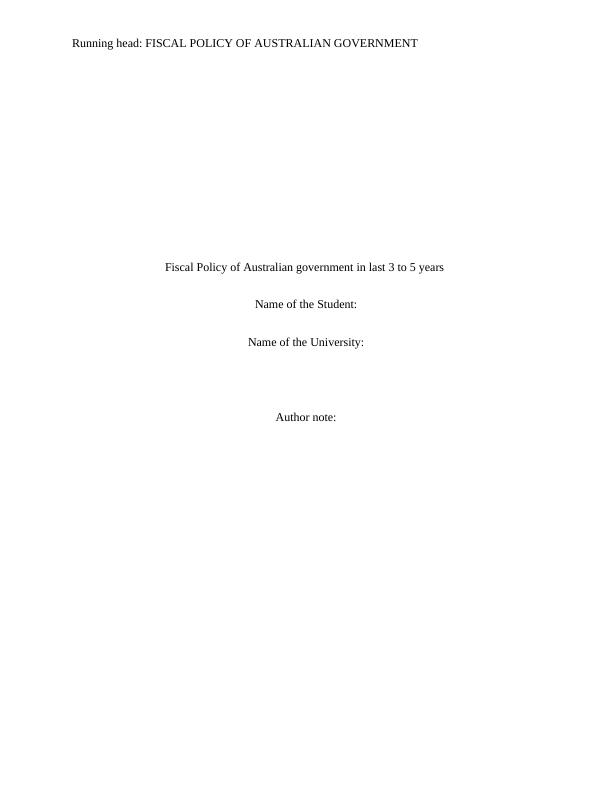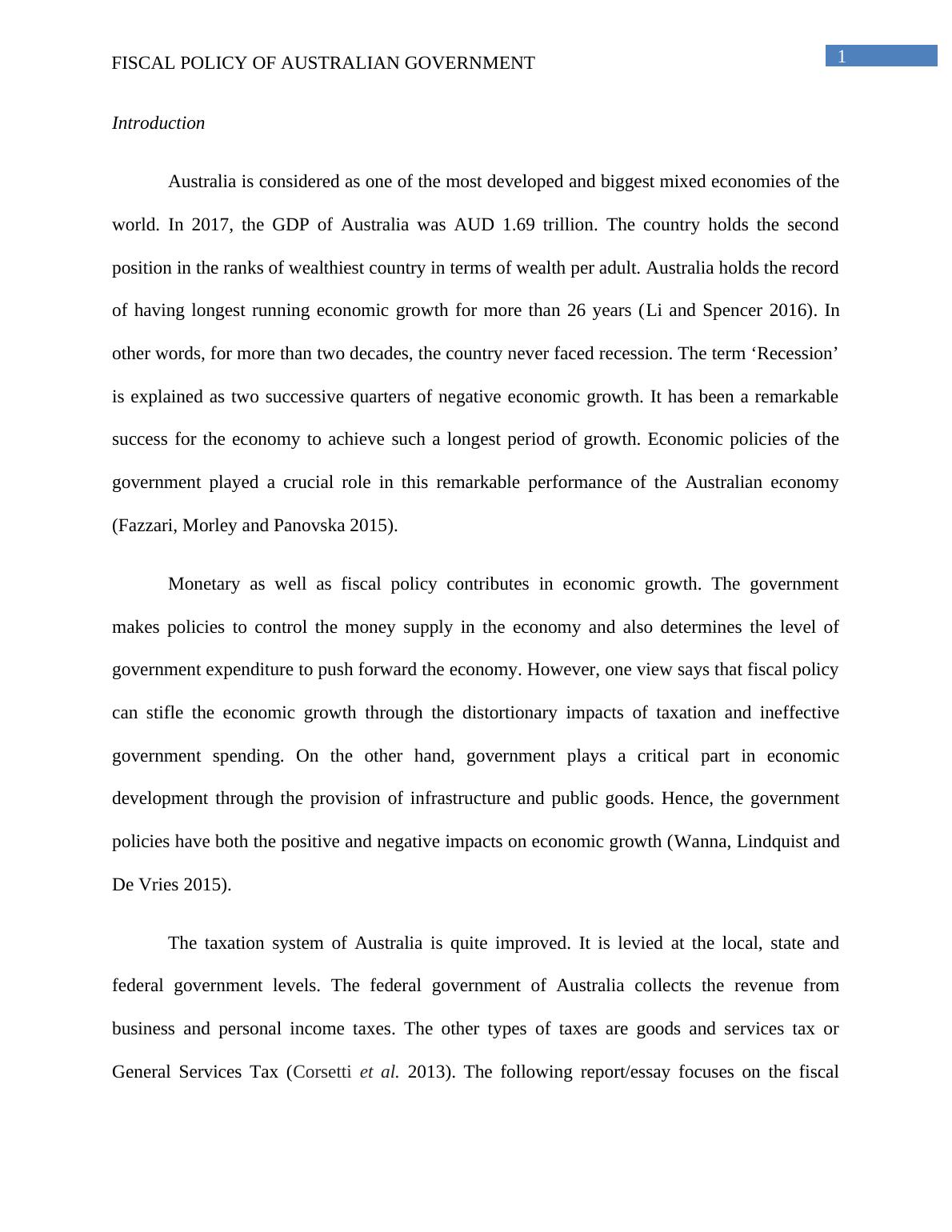Report on Fiscal Policy of Australian Government
15 Pages4110 Words40 Views
Added on 2020-04-07
Report on Fiscal Policy of Australian Government
Added on 2020-04-07
ShareRelated Documents
Running head: FISCAL POLICY OF AUSTRALIAN GOVERNMENT
Fiscal Policy of Australian government in last 3 to 5 years
Name of the Student:
Name of the University:
Author note:
Fiscal Policy of Australian government in last 3 to 5 years
Name of the Student:
Name of the University:
Author note:

1
FISCAL POLICY OF AUSTRALIAN GOVERNMENTIntroduction
Australia is considered as one of the most developed and biggest mixed economies of the
world. In 2017, the GDP of Australia was AUD 1.69 trillion. The country holds the second
position in the ranks of wealthiest country in terms of wealth per adult. Australia holds the record
of having longest running economic growth for more than 26 years (Li and Spencer 2016). In
other words, for more than two decades, the country never faced recession. The term ‘Recession’
is explained as two successive quarters of negative economic growth. It has been a remarkable
success for the economy to achieve such a longest period of growth. Economic policies of the
government played a crucial role in this remarkable performance of the Australian economy
(Fazzari, Morley and Panovska 2015).
Monetary as well as fiscal policy contributes in economic growth. The government
makes policies to control the money supply in the economy and also determines the level of
government expenditure to push forward the economy. However, one view says that fiscal policy
can stifle the economic growth through the distortionary impacts of taxation and ineffective
government spending. On the other hand, government plays a critical part in economic
development through the provision of infrastructure and public goods. Hence, the government
policies have both the positive and negative impacts on economic growth (Wanna, Lindquist and
De Vries 2015).
The taxation system of Australia is quite improved. It is levied at the local, state and
federal government levels. The federal government of Australia collects the revenue from
business and personal income taxes. The other types of taxes are goods and services tax or
General Services Tax (Corsetti et al. 2013). The following report/essay focuses on the fiscal
FISCAL POLICY OF AUSTRALIAN GOVERNMENTIntroduction
Australia is considered as one of the most developed and biggest mixed economies of the
world. In 2017, the GDP of Australia was AUD 1.69 trillion. The country holds the second
position in the ranks of wealthiest country in terms of wealth per adult. Australia holds the record
of having longest running economic growth for more than 26 years (Li and Spencer 2016). In
other words, for more than two decades, the country never faced recession. The term ‘Recession’
is explained as two successive quarters of negative economic growth. It has been a remarkable
success for the economy to achieve such a longest period of growth. Economic policies of the
government played a crucial role in this remarkable performance of the Australian economy
(Fazzari, Morley and Panovska 2015).
Monetary as well as fiscal policy contributes in economic growth. The government
makes policies to control the money supply in the economy and also determines the level of
government expenditure to push forward the economy. However, one view says that fiscal policy
can stifle the economic growth through the distortionary impacts of taxation and ineffective
government spending. On the other hand, government plays a critical part in economic
development through the provision of infrastructure and public goods. Hence, the government
policies have both the positive and negative impacts on economic growth (Wanna, Lindquist and
De Vries 2015).
The taxation system of Australia is quite improved. It is levied at the local, state and
federal government levels. The federal government of Australia collects the revenue from
business and personal income taxes. The other types of taxes are goods and services tax or
General Services Tax (Corsetti et al. 2013). The following report/essay focuses on the fiscal

2
FISCAL POLICY OF AUSTRALIAN GOVERNMENTpolicies of Australian government in the last three to five years. The positive and negative
aspects of the Australian fiscal policy and the influence on economic growth will be discussed in
the report/essay.
Fiscal policy
Fiscal policy is one of the two most important tools of the government of any country to
control the flow of the economy. The government of a nation makes adjustments in the
expenditure and the rate of taxes to observe and affect the economy through the method. This
policy is combined with monetary policy and applied in the economic system to direct the
economic goals of a nation (Condon et al. 2014).
Before the Great Depression, the governments of all the countries took the laissez-faire
approach towards the economy. In this approach, the government was not involved in the
economy, as people believed that less involvement of the government can lead to better business.
It was a fundamental part of the free market mechanism. However, after the Great Depression in
1930 and World War II, the need for government regulation was felt in the international
economy. The governments decided to take active part in regulating inflation, unemployment,
interest rates, exchange rates, cost, demand and supply of money in the economy. Hence, the
practice of policy formulation and implementation started to prevail in the world economy
(Furman and Shambaugh 2016).
John Maynard Keynes introduced the concept of fiscal policy. He stated in his theory
that, the governments can affect the macroeconomic activities and performances of an economy
by raising or reducing the levels of tax and public spending. This reduces inflation in the
economy, increases the employment and maintains the value for money. The balance between
FISCAL POLICY OF AUSTRALIAN GOVERNMENTpolicies of Australian government in the last three to five years. The positive and negative
aspects of the Australian fiscal policy and the influence on economic growth will be discussed in
the report/essay.
Fiscal policy
Fiscal policy is one of the two most important tools of the government of any country to
control the flow of the economy. The government of a nation makes adjustments in the
expenditure and the rate of taxes to observe and affect the economy through the method. This
policy is combined with monetary policy and applied in the economic system to direct the
economic goals of a nation (Condon et al. 2014).
Before the Great Depression, the governments of all the countries took the laissez-faire
approach towards the economy. In this approach, the government was not involved in the
economy, as people believed that less involvement of the government can lead to better business.
It was a fundamental part of the free market mechanism. However, after the Great Depression in
1930 and World War II, the need for government regulation was felt in the international
economy. The governments decided to take active part in regulating inflation, unemployment,
interest rates, exchange rates, cost, demand and supply of money in the economy. Hence, the
practice of policy formulation and implementation started to prevail in the world economy
(Furman and Shambaugh 2016).
John Maynard Keynes introduced the concept of fiscal policy. He stated in his theory
that, the governments can affect the macroeconomic activities and performances of an economy
by raising or reducing the levels of tax and public spending. This reduces inflation in the
economy, increases the employment and maintains the value for money. The balance between

3
FISCAL POLICY OF AUSTRALIAN GOVERNMENTthe fluctuating tax rates and public spending is very important to stabilize an economy
(Borcherding and Keynes 2015)
Fiscal policy is of two types, expansionary and contractionary. Expansionary fiscal policy
stimulates economic growth. It is most effective when business cycle is in the contraction phase.
To stimulate a stagnant economy, public spending needs to be increased and taxes should be
reduced. It also has a risk of rise in inflation in the economy. It is because when the quantity of
money increases in the economy, the aggregate demand for goods and services increases. This
causes the value of money to decrease. Hence, more money would be needed to buy same
quantity of goods. When an economy is slowed down, the level of unemployment increases and
consumer spending reduces. Then the government can stimulate the economy by reducing the tax
rates. Thus, people would have more money in their hands to spend on the public goods and
services. This way the consumer demand for goods and services increases leading to a rise in the
total production, employment and economic growth (Hansen 2013).
On the other hand, when the inflation becomes too high, then for a slow down in the
economy, government uses contractionary fiscal policy. The tax rates are raised to pump out the
excess money from the economy and government spending is reduced to lower the money
circulation, as long running inflation can damage the economic growth. If this continues for a
long time, the economic growth would be disturbed and level of unemployment would increase
(Arrow and Kruz 2013).
Taxation and government spending are the tools of fiscal policy. Taxes are levied on
income of people, gains from investment, sales of commodities and properties and services.
FISCAL POLICY OF AUSTRALIAN GOVERNMENTthe fluctuating tax rates and public spending is very important to stabilize an economy
(Borcherding and Keynes 2015)
Fiscal policy is of two types, expansionary and contractionary. Expansionary fiscal policy
stimulates economic growth. It is most effective when business cycle is in the contraction phase.
To stimulate a stagnant economy, public spending needs to be increased and taxes should be
reduced. It also has a risk of rise in inflation in the economy. It is because when the quantity of
money increases in the economy, the aggregate demand for goods and services increases. This
causes the value of money to decrease. Hence, more money would be needed to buy same
quantity of goods. When an economy is slowed down, the level of unemployment increases and
consumer spending reduces. Then the government can stimulate the economy by reducing the tax
rates. Thus, people would have more money in their hands to spend on the public goods and
services. This way the consumer demand for goods and services increases leading to a rise in the
total production, employment and economic growth (Hansen 2013).
On the other hand, when the inflation becomes too high, then for a slow down in the
economy, government uses contractionary fiscal policy. The tax rates are raised to pump out the
excess money from the economy and government spending is reduced to lower the money
circulation, as long running inflation can damage the economic growth. If this continues for a
long time, the economic growth would be disturbed and level of unemployment would increase
(Arrow and Kruz 2013).
Taxation and government spending are the tools of fiscal policy. Taxes are levied on
income of people, gains from investment, sales of commodities and properties and services.

End of preview
Want to access all the pages? Upload your documents or become a member.
Related Documents
Fiscal Policy Economic Assignmentlg...
|16
|3439
|289
Macroeconomic Policies And Great Recessionlg...
|5
|1106
|31
Role of Fiscal and Monetary Policy in UKlg...
|21
|1008
|71
Economic Analysis for Business: Assignmentlg...
|21
|3886
|31
Managerial Economics: Fiscal Policy, Monetary Policy and Taxationlg...
|7
|851
|307
POL2000/ Political and Economic Ideaslg...
|5
|1185
|17
